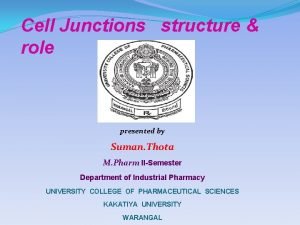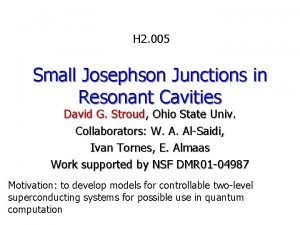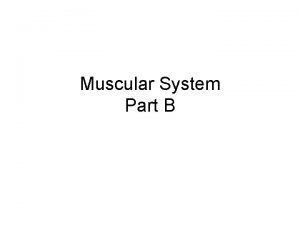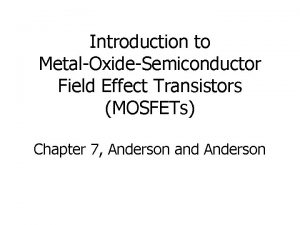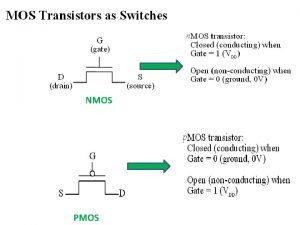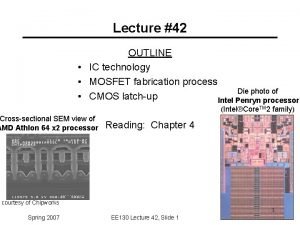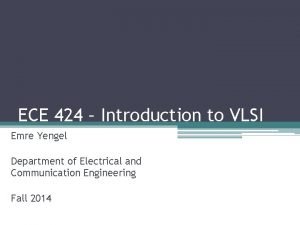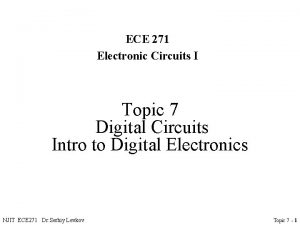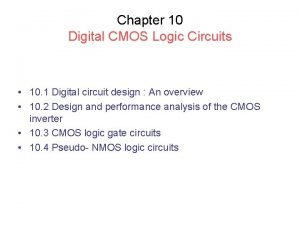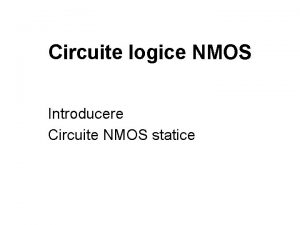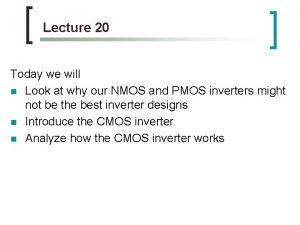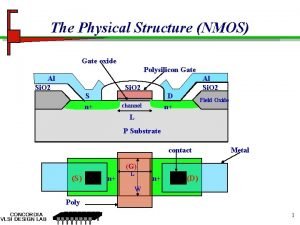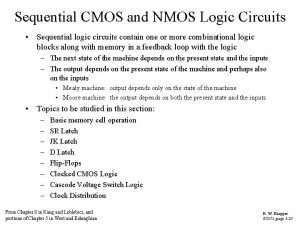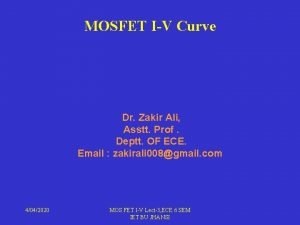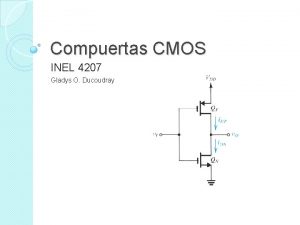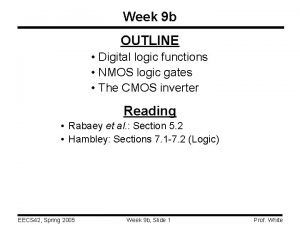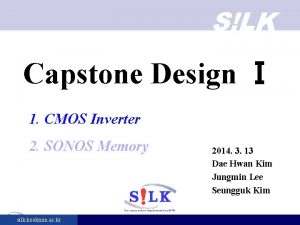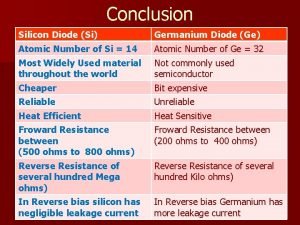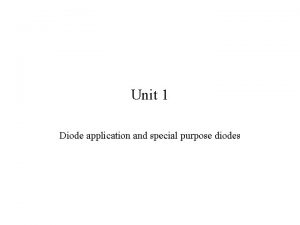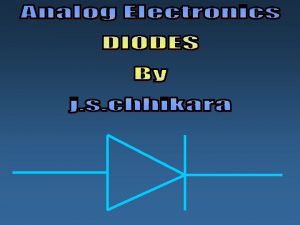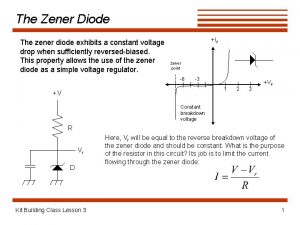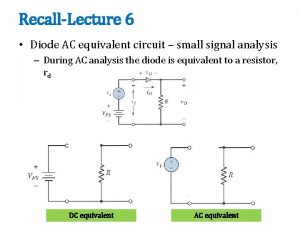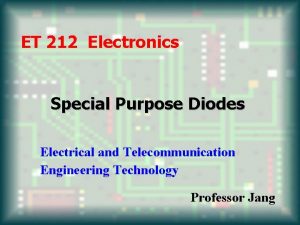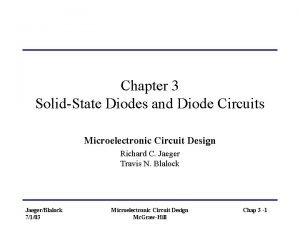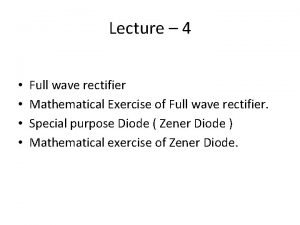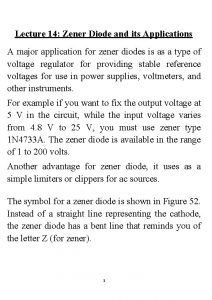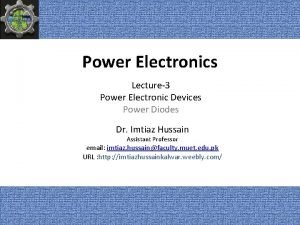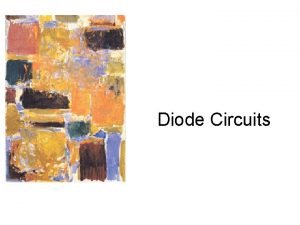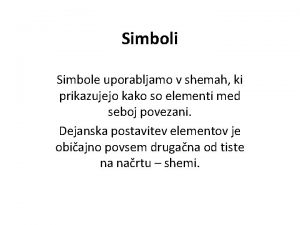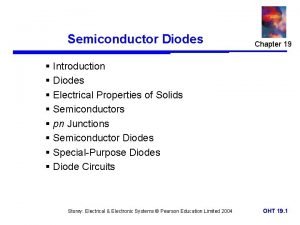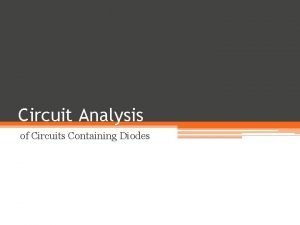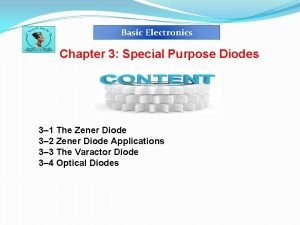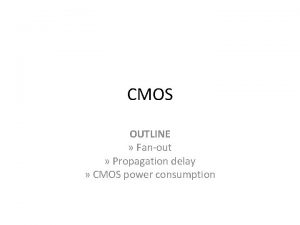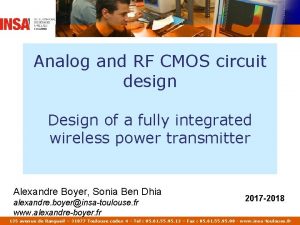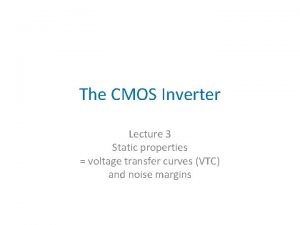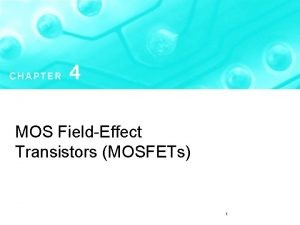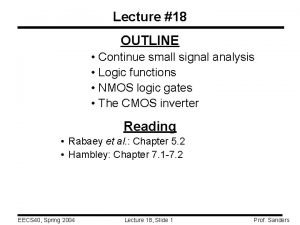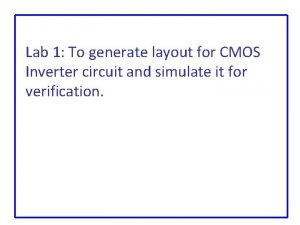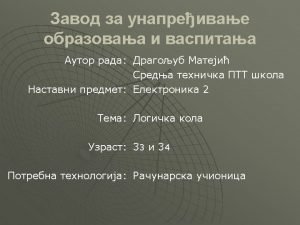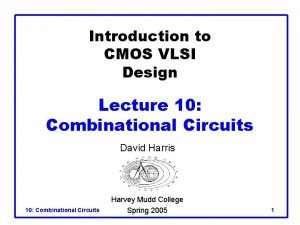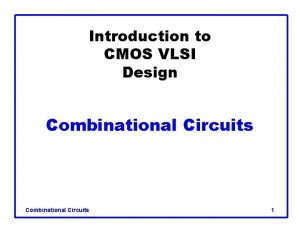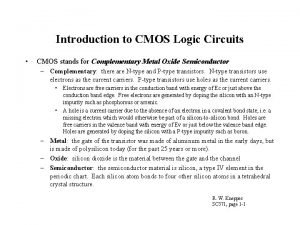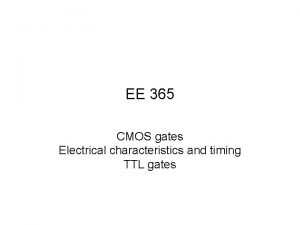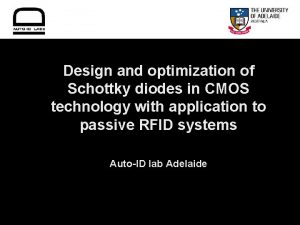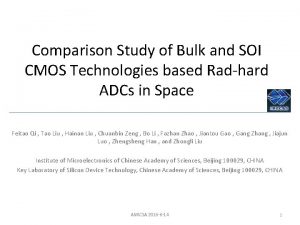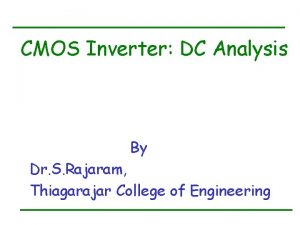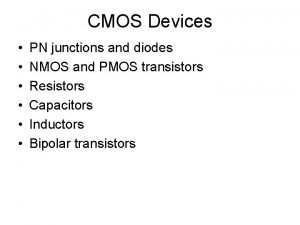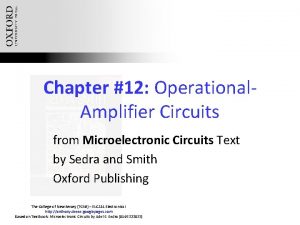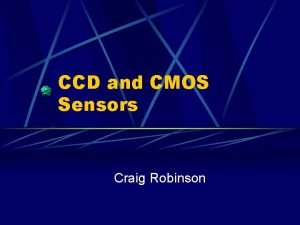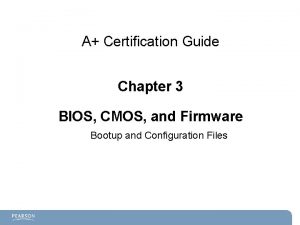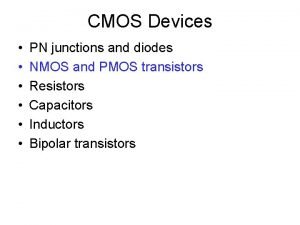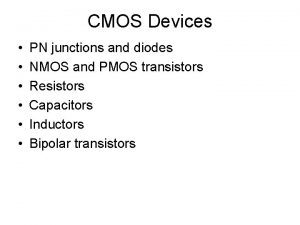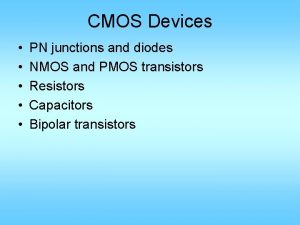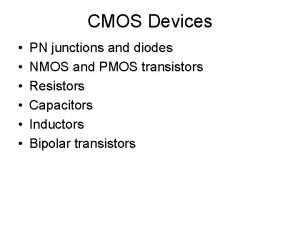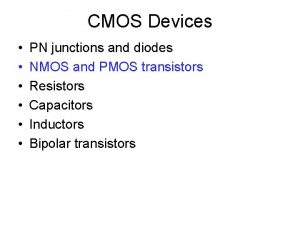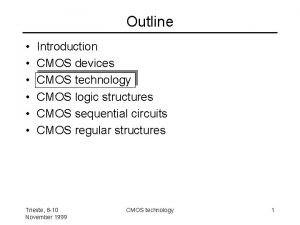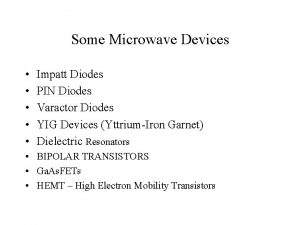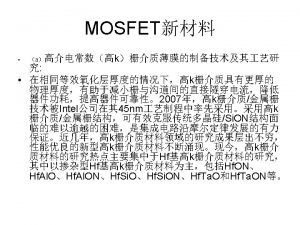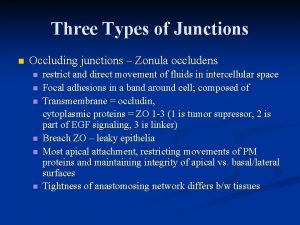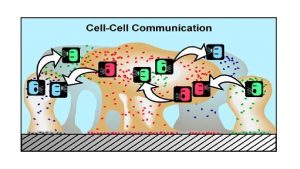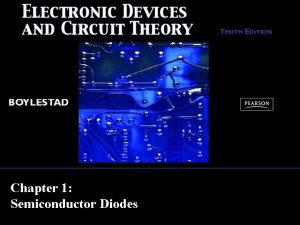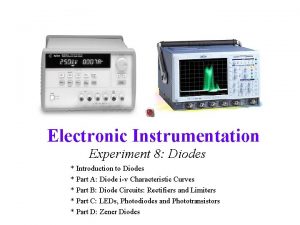CMOS Devices PN junctions and diodes NMOS and
































































- Slides: 64

CMOS Devices • • • PN junctions and diodes NMOS and PMOS transistors Resistors Capacitors Inductors Bipolar transistors

The MOS Transistors

The MOS Transistors

CMOS Device Model • Objective – Hand calculations for analog design – Non-idealities and their effects – Efficient and accurate simulation • CMOS transistor models – Large signal model – Small signal model – Simulation model – Noise model

Good for VDS <VGS -VTH After that, ID become saturated.


Linear in deep triode Pro: voltage control of resistivity. Con: nonlinear resistor. As v. DS 0, ron

MOST Regions of Operation • Cut-off, or non-conducting: v. GS <VT – i. D=0 approximately • Conducting, or on: v. GS >=VT – Saturation: v. DS > v. GS – VT – Triode or linear or ohmic or non-saturation: v. DS <= v. GS – VT Saturation voltage:

With channel length modulation

i. D vs v. DS for several VGS gds gm*DVGS

Influence of Channel Length on l Lmin = 0. 25 Johns and Martin book gives an approximate formula with l 1/L At >=2*Lmin, l is small, Ro is large After 1 um, l remains about the same

Influence of VBS changes threshold voltage, and hence changes i-v curve.

Temperature Dependence of Mobility Linear Temperature Dependence of threshold voltage Saturation Velocity Junction capacitance Barrier potential

This is nonlinear if Vbs is temperature dependent



0. 35 um process ZTC biasing Referenced from Filanovsky’s paper

Reality: no single point crossing ID Not just one single crossing In AMI 0. 6 process Test on a single NMOS biased with fixed Vgs and Vds Vgs


AMI 0. 6 To refine the value. Vgs=1. 12 V Vgs=1. 14 V Optimum curve TC = 41 ppm/C Vgs=1. 17 V

Generic 018 Vgs=0. 717 V TC=27 ppm/C Vgs=0. 721 V Vgs=0. 727 V

Large signal model for approximate hand caculation

Capacitors Of The MOSFET


Capacitors in Cutoff

Capacitors in Saturation

Capacitors in Triode

Small signal model

Typically: VDB, VSB are in such a way that there is a reversely biased pn junction. Therefore: gbd ≈ gbs ≈ 0

In saturation: But

Intrinsic DC voltage gain: gm/gds = gm*rds

In non-saturation region

Intrinsic gain For large gain, use small ID or small over drive voltage, or in moderate to weak inversion.

High Frequency Figure of Merit w. T • • • AC current source input to G AC short S, D, B to gnd (i. e. constant voltages) Measure AC drain current output Calculate current gain Find frequency at which current gain = 1. Ignore rs and rd, Cbs, Cbd, gds, gbd all have zero voltage drop and hence zero current • Vgs = Iin /jw(Cgs+Cgb+Cgd) ≈ Iin /jw(Cgs+Cgd) • Io = − (gm − jw. Cgd)Vgs ≈ − gm Iin /jw(Cgs+Cgd) • |Io/Iin| = |gm − jw. Cgd|/w(Cgs+Cgd) ≈ gm/w(Cgs+Cgd)

amplification |Io/Iin| 0 d. B attenuation w. T w

• At w. T, current gain =1 • w. T ≈ gm/(Cgs+Cgd)≈ gm/Cgs • or

For fastest operation, use Vod near but before f. T peak For power efficiency, use Vod before f. T corner

High Frequency Figures of Merit wmax • • AC current source input to G AC short S, B to gnd Measure AC power into the gate Assume complex conjugate load Compute max power delivered by the transistor Find maximum power gain Find frequency at which power gain = 1.


gdo vs gm in short channel

gdo vs gm in short channel


Insights: • gdo increases all the way with current density Iden • gm saturates when Iden larger than 100 m. A/mm – Velocity saturation, mobility degradation ---short channel effects – Low gm/current efficiency – High linearity • For power efficiency and gm efficiency – Use moderate to low current density – Use small over drive voltage

To Av: (W/L), m, ID, l, set Vo. Q at mid rail For high speed: Veff, m; L, Cgd, rg For better linearity: Vds, Vdb, set Vo. Q at mid rail Veff range: <~0. 5 V; or <~0. 3 V for efficiency ID/W range: <100 m. A/mm; or <40 m. A/mm for efficiency

Intrinsic voltage gain of MOSFET Sweep V 1 Measure vgs Intrinsic voltage gain = gm/go = Dvds/Dvgs for constant Id

Weak inversion • When VGS is reduced to Vth, the drain current does not go to zero – It does not follow square law – It does not follow exponential law • When VGS is markedly below Vth, the drain current becomes an exponential function of VGS. – Behaves very much like a diode

A model from weak to strong inv

In strong inversion, n is about 1

In weak inversion

In weak inversion If vt = 25 m. V, n=2, gm/ID = 20 n=1. 5, gm/ID = 27 n=1. 2, gm/ID = 33

ID vs VGS Exponential model Square law model simulation

ID/(W/L) vs VG is sensitive to VBS

gm/ID vs VG is also sensitive to VBS

But gm/ID vs ID/(W/L) has fixed shape

Related VDD insensitive circuits • Filanovsky, etc, “Mutual Compensation of Mobility and Threshold Voltage Temperature Effects with Applications in CMOS Circuits”. • G. Giustolisi “A Low-Voltage Low-Power Voltage Reference Based on Subthreshold MOSFETs”. • Ka Nang Leung “A CMOS Voltage Reference Based on Weighted VGS for CMOS Low-Dropout Linear Regulators”. • Bernhard Boser. “Analog Circuit Design with Submicron Transistors". IEEE SSCS Meeting, Santa Clara Valley, May 2005.




TSMC 0. 18 um Process

TSMC 0. 18 um Process

TSMC 0. 18 um Process

TSMC 0. 18 um Process

TSMC 0. 18 um Process

TSMC 0. 18 um Process
 Difference between gap junctions and desmosomes
Difference between gap junctions and desmosomes Layers of cell wall
Layers of cell wall Define cell junction
Define cell junction Microorganismos comensales
Microorganismos comensales Adding a junction in hec-ras
Adding a junction in hec-ras Fusiform muscles
Fusiform muscles Josephson junctions
Josephson junctions Eccentric movement
Eccentric movement Nmos symbols
Nmos symbols Nmos and pmos
Nmos and pmos Nand gate mosfet
Nand gate mosfet Nmos inverter with resistive load
Nmos inverter with resistive load Fabrication process
Fabrication process Nmos inverter with depletion load
Nmos inverter with depletion load Nmos inverter with resistive load
Nmos inverter with resistive load Nmos inverter
Nmos inverter Inversor nmos
Inversor nmos Nmos inverter
Nmos inverter N+ polysilicon
N+ polysilicon Sr latch using cmos
Sr latch using cmos Gradual channel approximation
Gradual channel approximation Inversor nmos
Inversor nmos Nmos
Nmos Static cmos inverter
Static cmos inverter A si and ge diode
A si and ge diode Diodes
Diodes State any two special purpose diodes
State any two special purpose diodes What are diodes made of
What are diodes made of Zener diode oscillator
Zener diode oscillator Equivalent circuit for zener diode
Equivalent circuit for zener diode What are special purpose diodes
What are special purpose diodes Solid state diodes
Solid state diodes Full wave rectifier 4 diodes
Full wave rectifier 4 diodes What is zener diode explain its applications
What is zener diode explain its applications Power diodes types
Power diodes types Vt diode
Vt diode Simbol potensiometer
Simbol potensiometer Introduction to diodes
Introduction to diodes Circuit analysis with diodes
Circuit analysis with diodes Special purpose diodes
Special purpose diodes Comparison of logic families table
Comparison of logic families table Literaly elements
Literaly elements Computer system input
Computer system input Fanout of cmos
Fanout of cmos Device modeling for analog and rf cmos circuit design
Device modeling for analog and rf cmos circuit design Difference between lod and sti in cmos
Difference between lod and sti in cmos Vtc of cmos inverter
Vtc of cmos inverter Cmos cross section
Cmos cross section Cmos inverter small signal model
Cmos inverter small signal model Cmos inverter layout
Cmos inverter layout Rtl inverter
Rtl inverter Skewed gates in vlsi
Skewed gates in vlsi Compound gate cmos
Compound gate cmos Cmos stands for
Cmos stands for Cmos vs ttl
Cmos vs ttl Diode layout in cmos
Diode layout in cmos Bulk cmos
Bulk cmos Cmos process flow
Cmos process flow Layout design rules in cmos vlsi
Layout design rules in cmos vlsi Dc characteristics of cmos inverter
Dc characteristics of cmos inverter Cmos diode
Cmos diode Ttl cmos ecl comparison table
Ttl cmos ecl comparison table Cmos amplifier
Cmos amplifier Ccd vs cmos
Ccd vs cmos Cmos certification
Cmos certification
